2008 Exchange
Alexander stands out among young business owners
Alumna recalls days at K-State as her children make college choices
Commitment to people translates into business success
Alumnus thrives on change and pressure
Students ride highs and lows of the pit
Learning the ropes at a distance
Emerald Isle agriculture comes to life
K-State recovers from June tornado
Ag Econ Alumni and Faculty honored for success
![]()
Greetings from the Interim Department Head, Allen Featherstone
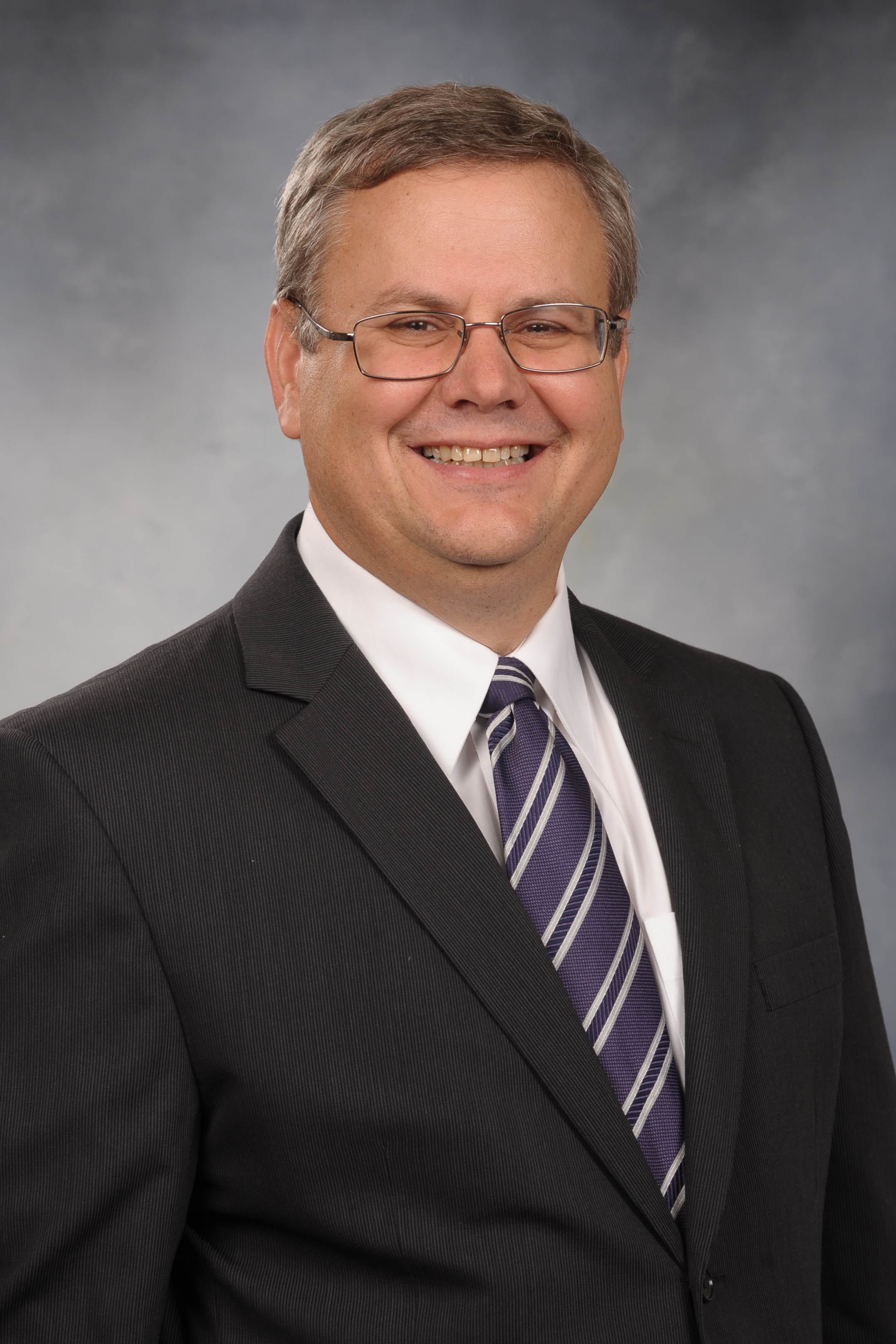 For the past two years K-State Agricultural Economics has been guided under the competent direction of Dr. Bryan Schurle. As he now moves into research and teaching roles we wish him the best and are thankful for his contributions.
For the past two years K-State Agricultural Economics has been guided under the competent direction of Dr. Bryan Schurle. As he now moves into research and teaching roles we wish him the best and are thankful for his contributions.
As the interim department head, I am pleased to provide leadership through the next year as we continue to pursue our mission, streamline our programs, and prepare for new leadership.
This year affords us the opportunity to serve K-State students, the people of Kansas, the nation, and the world with our practical, research-based programs. In this time of uncertainty, you can be confident that your alma mater continues to lead in the educational areas of agribusiness, farm management, trade, finance, and marketing. New tools, like the Cattle Risk Management Information Library, are assisting producers to manage their risk amidst this current volatile environment. The Masters of Agribusiness program continues to extend its global reach through nine international partner institutions in eight different regions around the world. Scholarships totalling more than $170,000, provided by the faithful contributions of alumni and friends, make it easier for our 325 undergraduate students to pursue their studies.
We will pursue the most qualified individual as we fill the position of department head. An executive who understands and values the research, extension, and teaching missions of the department while maintaining our service to the state of Kansas. We gladly receive your input in this process, and look forward to your participation. We welcome the talents and skills each of you offer to our department whether they are your time, encouragement, advice, expertise in the classroom, recruiting efforts, or monetary gifts. Together we can look forward with optimism to the challenges the future presents.
Go State!
Learn more:
Cattle Risk Management Library (CRMIL): www.agmanager.info/CRMIL
Masters of Agribusiness: www.mab.ksu.edu
Undergraduate programs: www.ageconomics.ksu.edu
Research and Extension initiatives: www.agmanager.info
Alexander stands out among young business owners
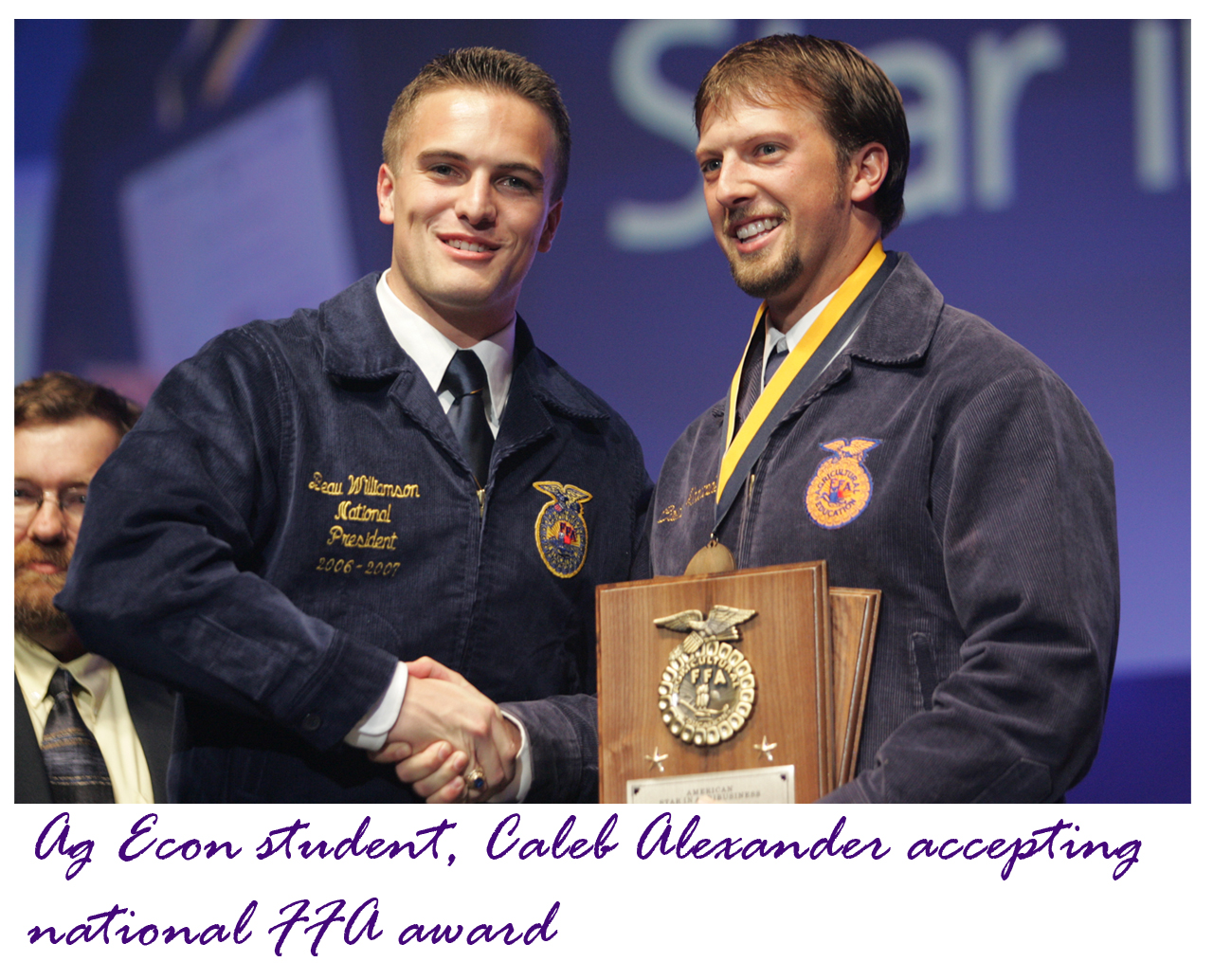 Ag Econ student, Caleb Alexander, has fond childhood memories of tagging along with his father as he checked sprinklers and drove tractors for the family’s farm and ranch in Garden City, Kan. He always knew he’d be a farmer, just like his father, so he decided to pursue his own hay bailing operation, a business that has now earned him top honors.
Ag Econ student, Caleb Alexander, has fond childhood memories of tagging along with his father as he checked sprinklers and drove tractors for the family’s farm and ranch in Garden City, Kan. He always knew he’d be a farmer, just like his father, so he decided to pursue his own hay bailing operation, a business that has now earned him top honors.
The National FFA Organization named Alexander 2008 Star in Agribusiness, one of the organization’s highest honors, at the 80th National FFA Convention.
During the convention, Alexander and three other finalists participated in interviews conducted by a panel of judges, who named the top candidate in each area. Those areas are American Star Farmer, American Star in Agribusiness, American Star in Agricultural Placement and American Star in Agriscience. Alexander was presented with the award during an onstage convention ceremony and received a plaque and an award of $4,000.
In 2001, Alexander got the idea to start his own operation when he and his father noticed a shortage of small, high-quality, square bale producers in their area. Seeing an opportunity, his father suggested adding value to the family’s alfalfa crop by putting it up into small squares. With the help of his father, Alexander created CA Hay and purchased a used baler and accumulator and began baling hay in the summer of 2002.
“I’ve learned many valuable lessons from operating CA Hay,” says Alexander. “A few of those lessons are the importance of ingenuity, the value of satisfying customers and the reward of honest, hard work.”
Five years later, he now bales, sells, and delivers small squares of high-quality alfalfa hay to several customers including local horse owners. In addition to baling and selling hay, Alexander also custom bales to a customer base of more than 40 people from seven different states.
Alexander will soon graduate with a degree in agricultural economics.
Alumna recalls days at K-State as her children make college choices
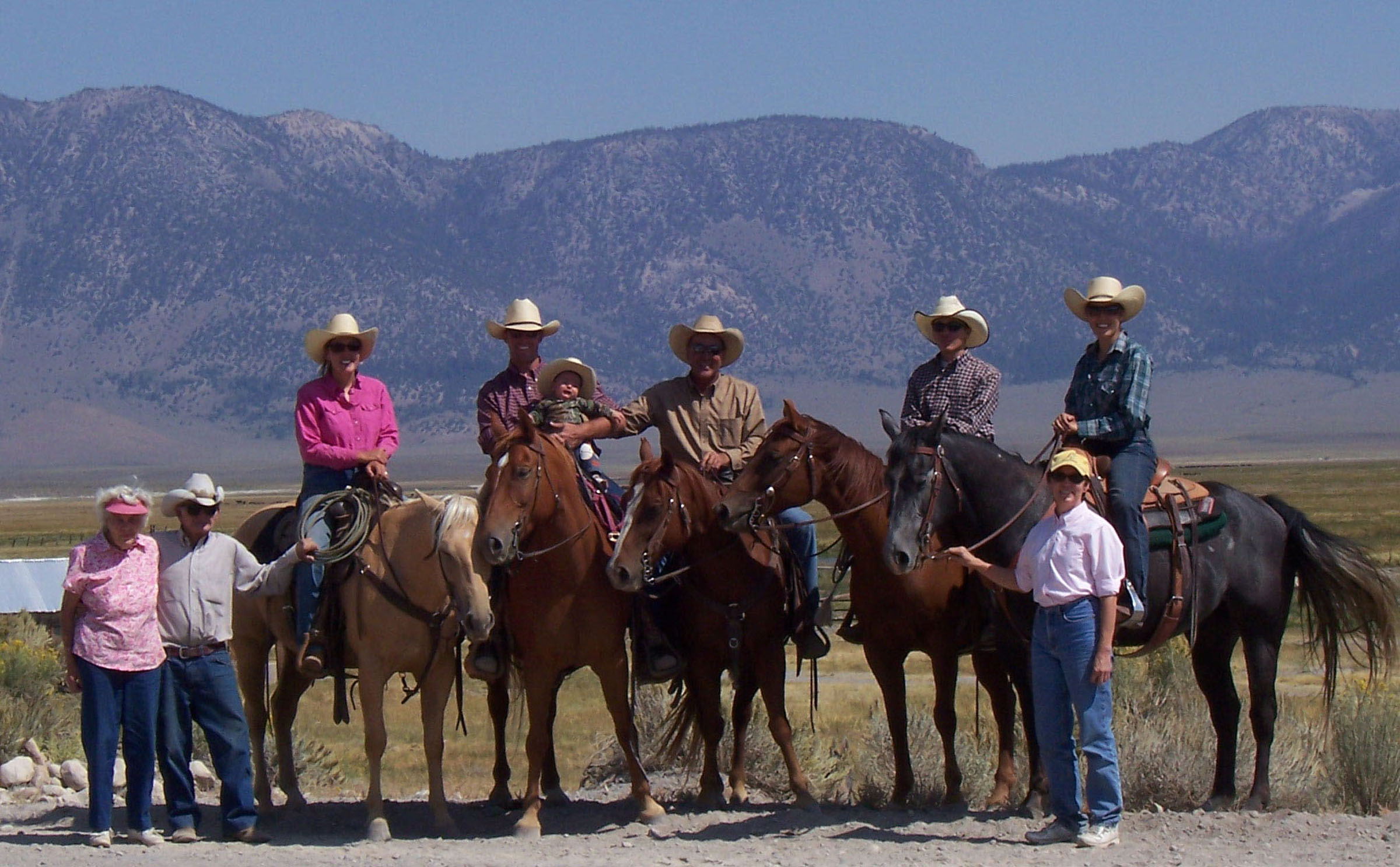 In 1977, her home in Prairie Glen didn’t have much of a backyard, so when California native, Alonna Giacomini, and her husband, Gary, found a community garden across town they quickly signed up hoping to grow a bit of home while attending K-State.
In 1977, her home in Prairie Glen didn’t have much of a backyard, so when California native, Alonna Giacomini, and her husband, Gary, found a community garden across town they quickly signed up hoping to grow a bit of home while attending K-State.
“We were so proud of ourselves for being the first people at the garden preparing the ground and sowing our plants. The weather was beautiful that March and we were shocked more people weren’t out there with us,” Alonna shared. “But the joke was on us; our beans were a few inches out of the ground when a late freeze killed them. Those Midwestern gardeners got a big kick out of watching us Californians planting too early.”
Thankfully the transition to graduate school resulted in much better fruit than their first efforts at tilling the Kansas soil.
Memories like these accompanied Alonna, M.S. ’79, when she stopped by K-State with her family during a whirlwind tour of Midwest universities this summer. Her mission was to help her children decide where to attend school.
“I’ve told my kids stories about my time at K-State since they were little. Now that they’ve seen the places we lived my history is alive to them,” Alonna said.
It’s a sense of belonging and community, in addition to a quality academic program, that Alonna hopes her children will find as well.
“As parents, we want our kids to be in a safe community. We’re looking for a school in a town that revolves around the university, and one that has a major emphasis in agriculture. In addition, we want to find a school where the faculty has a strong interest in what the kids are pursuing.”
Alonna’s own decision to attend graduate school at K-State was easily made.
“I had studied agricultural business management at Cal Poly. My husband was researching schools for his graduate degree in animal science. He did all the investigative research. I do remember at the time we were impressed with the fact that agriculture played such a big role in the Kansas economy, something far different than the much diversified economy of California. We had read something to the effect that the population in Kansas was 2 million, but the cattle population was 6 million. Beyond agriculture’s solid role, we settled on K-State because of the quality people.”
Gary began work on his masters degree and Alonna found the agricultural economics program to be a good fit for her. While in the program Alonna worked for Dr. Bryan Schurle as a teaching assistant.
“I loved working for Dr. Schurle. He was brand new to the department and brought a fresh enthusiasm that I enjoyed a lot. Then I did my thesis under Dr. Don Pretzer. He really guided me through the process of learning how to write and compile my thesis. I appreciated his attention to detail and the opportunity to work for such an intelligent man.”
Alonna and her husband completed their degrees and returned to California to work in agribusiness and education. In 1985, her father had the opportunity to expand the family operation in the Owens valley. He asked if they would want to come join the family business. It was something they couldn’t pass up.
Currently, four generations are involved in the Cashbaugh - Giacomini cow-calf operation. The family summers their cattle near Mammoth Mountain Ski Resort at 7000 feet and winter the cows near Bishop, CA at 4000 feet. Alonna focuses mostly on the accounting area, but finds herself involved in each aspect of the business throughout the year.
“We work all the brandings as a family, and do the cooking for all the crews. We flood irrigate both summer and winter pastures between April 1 and Oct. 1 and all of the kids ride. Now, it seems like I find myself babysitting our new grandbaby and driving the truck a lot,” she said laughing.
As Alonna has nurtured her business and family, she hopes she has passed an appreciation for community and education on to her children.
“I have a respect for folks that live in the Midwest. They’re great people when it comes down to it. In California, we’re the number one state in agricultural production, but the population base is not agriculturally oriented. In the Midwest, that’s where the heart of agriculture resides. Ultimately, it was the people that brought us to K-State and made it our home while we stayed. To experience, even for a short while, the support of a major portion of the state and region comprising the agricultural community – that’s what we want and hope for our kids,” she said.
![]()
Commitment to people translates into business success
You won’t find agricultural economics alum, Terry Kohler, writing a book on management strategy. His wisdom may never reach the bestseller’s list, but it has successfully guided the Farmers Cooperative Elevator Company in Garden Plain, Kansas for more than twenty years. Kohler is the first to attribute an emphasis on people as the key to his success.
“We’ve been very fortunate at the Co-op to have a foundation of good relationships: employees who are grounded in the community and invested in their work, a great board that makes decisions well together, and most importantly loyal patrons that have kept the business humming,” he said.
A homegrown success story, Kohler grew up on the farm near Garden Plain attending elementary and high school in Cheney, Kansas.
“My father was a small farmer and I knew returning to the farm was going to be a challenge. Looking for options during junior college, I got involved in a program called Careers in Cooperatives. I shadowed old time managers on the job for two years. Finally, I took some advice from the local banker, he said if I was going to complete a four year degree I should to do it now. I went straight into agricultural economics at K-State and never looked back,” he shared.
Toward the end of his degree, Kohler saw opportunities ready to be taken. After several interviews, including one with Cargill in Minnesota, Kohler solidified his desire to be back home.
In Garden Plain, Tony Bergkam, then manager of the Co-op, offered Kohler a position.
“He had me doing everything: crop applicator, working the feed store, the elevator, and the office. He made me responsible for taking care of the daily business. We didn’t have titles then, I guess that’s why I’m not too fond of titles now. ‘Whatever it takes to get the job done,’ that was the philosophy,” Kohler said.
In 1985, Bergkam retired after working forty years at the elevator. Kohler accepted the job as manager. He believes he was in the right place at the right time; others were already seeing his leadership abilities.
Greg Reno, vice president of the Co-op, remembers Kohler as low-key and unassuming, able to give people responsibilities accompanied with coaching and good counsel.
“I’ve known Terry since he was in high school, and I’ve worked with him on various levels, first as a customer and now as a member of the board. Terry established a supportive and nurturing environment. He created clear expectations and understanding of the tasks at hand,” Reno said.
Kohler insists his business philosophy translates across the board, no matter the scale of the operation.
“By the end of your career, in many cases, you’ve spent more time with the people you work with than your own family. To keep good employees you’ve got to have a good working environment,” Kohler said.
“Each quarter we meet with all fifty employees. We go over financials, culture, challenges and other timely issues. We may not be structured enough, but we go over it as equals. When everyone has an understanding of where the company stands there are fewer surprises,” he added.
Customers also receive the same sincerity in their business transactions with the Co-op.
“We’re here to provide a service to our customers. Farmers are already up against a tough business environment. We want to earn their business each and every time they have an interaction with us. We’ve got to prove this is a good place to do business. We offer inputs and market products at a fair price, we may not be the highest or lowest, but we’re fair,” Kohler said.
Due to Kohler’s leadership the Co-op is strongly situated to endure the current economic climate, Reno said.
“Member support of the Co-op is very strong. Our financial results can be directly attributed to management. The company has been optimistic with acquisitions, but not overly naive,” Reno explained.
“Terry is not one to panic whenever there is an issue that arises. He approaches it very methodically. We’ll address issues one by one as they come up. He keeps the membership and board informed and he’ll devise strong strategies,” he said.
In addition to clear communication at every level, Kohler encourages involvement in the community through his example. He has served on the local school board for four terms, a local bank board for fifteen years, and has some involvement on scholarship committees giving back to young people. He and his wife, Susan, are also involved in their local church.
“Your community gives to you. They’re important in providing for your family, and I think we need to give back too,” he said.
Another way Kohler has given back is through his service in the Arthur Capper Cooperative Center (ACCC). The ACCC provides research-based education programs targeted at cooperative business leaders, employees, and members. Kohler has worked with Professor and ACCC Director, Dr. David Barton, on numerous educational projects.
“Terry Kohler is a phenomenal leader with a very calm, persistent and warm leadership style. People just naturally like and trust him because of his competent and caring approach. He was the teacher and I became the student as I watched him successfully navigate through a complex and politically sensitive merger negotiation using this style,” Barton said.
Over the last 23 years he has grown and strengthened his company through good times and bad. Other co-op leaders recognized his talents and willingness to serve by electing him to the board of the Kansas Cooperative Council, and that board elected him as the board chair in 2005-06. He was appointed as a co-op industry representative on the ACCC Advisory Council in 2004, a position he continues to hold. In addition, he assumed the leadership of the ongoing ACCC fundraising campaign which is well on its way to tripling the endowment for the ACCC.
Barton says of Kohler, “Faculty, students, and leaders in the co-op community are now and forever improved because of his advice and support for education.”
Kohler believes serving with the ACCC is well worth his time and effort.
“The idea of cooperatives and the co-op business model has a major role in the future.. There are so many more things we can do together than we can apart. The ACCC pulls us together to give us training and a vision for the future. We are confident they will continue to lead,” Kohler said.
Alumnus thrives on change and pressure
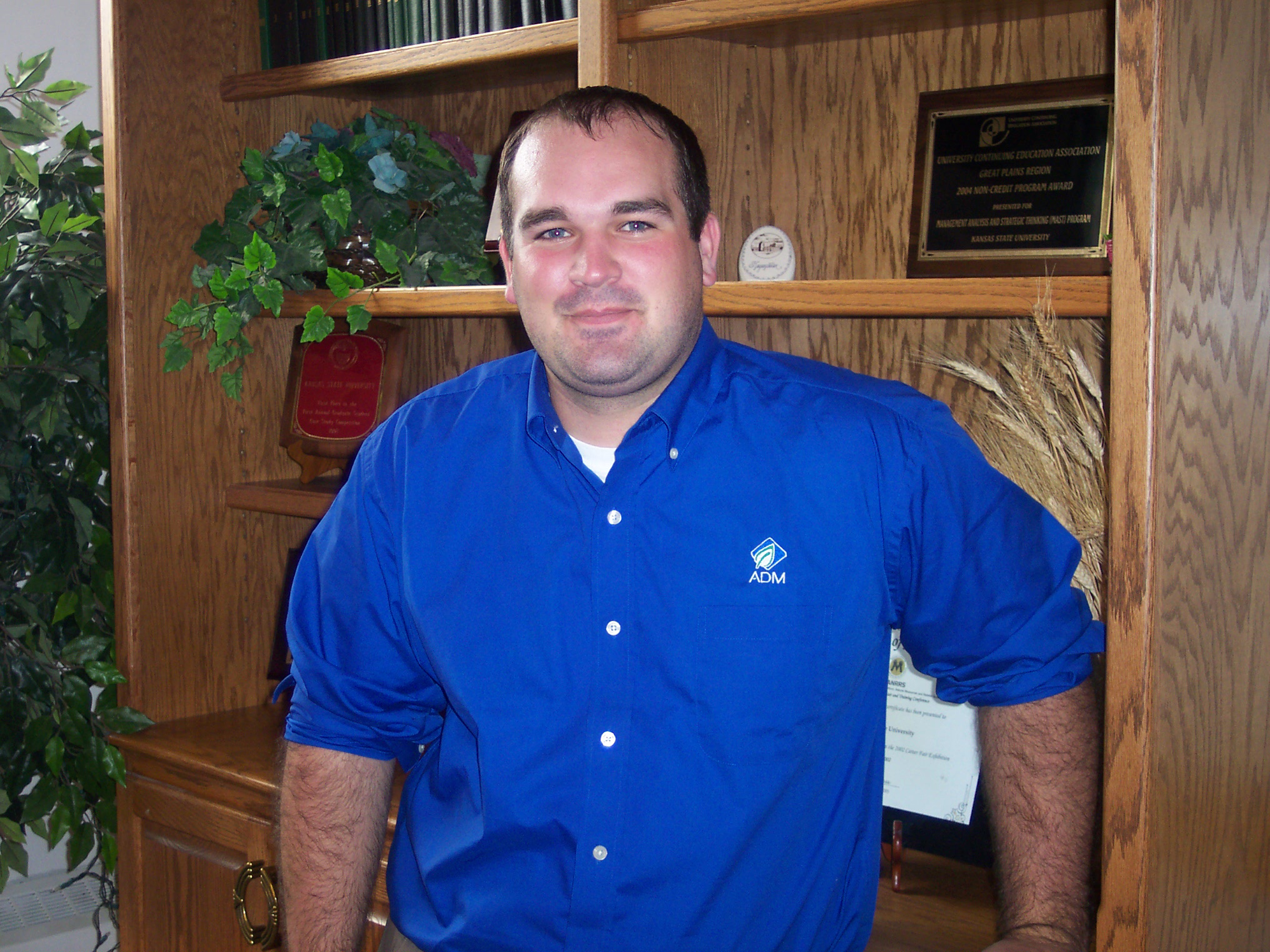 Justin Patterson wakes at 5:30 am and heads out the door without a cup of coffee.
Justin Patterson wakes at 5:30 am and heads out the door without a cup of coffee.
“I used to drink two or three cups of coffee in the morning, now if I drink one, I’m already too hyper for the day,” he said smiling.
Patterson works as a commodity trader for ADM and counts on the job to provide any needed adrenaline. More than a million dollars passing through his hands each day can create quite a trader’s high.
“When the markets rally and the phones are ringing off the hook, you reach this point where your heart is beating outside your chest. The adrenaline pumps through you,” Patterson said.
His desire to work in commodity trading began in Dr. Sean Fox’s class at K-State.
“We did pit simulations and lost alot of money. It was good that it wasn’t our own -- but it felt real enough to give you a taste of what trading was like,” he recalled.
Patterson felt well prepared for the demanding day to day work environment he now lives. His classes gave him a strong foundation for the markets as well as an understanding of risk management tools. However, it isn’t just Dr. Fox’s class that he utilizes.
“I’m still learning, but I feel like I’m ahead of the curve. I use my Ag Econ training each day, not just in dealing with commodities. I think as broadly as economic rent when I’m analyzing the markets,” he shared.
Even though he felt prepared, commodity trading isn’t for the faint of heart. The work demands long hours and constant vigilience.
“It’s a stressful job, definetly a young man’s career. ADM does a great job of keeping you moving so that you are working with different commodities and with different people. If you can multi-task and handle pressure and you like an ever changing environment, commodity marketing is for you,” he said.
“Some days you wish you had two extra sets of arms to get everything done. You’re making choices while the market is for you or against you. No matter what, you can count on the fact that when the market goes it goes.
Market volatility has added another dimension to Patterson’s job.
“Volatility makes the job more interesting, but also increases the risk so that time is more valuable than it used to be. In the past the markets could move 10 cents in a day, but now they can move more than a dollar,” he said.
But even with the pressure of an intense environment, Patterson manages to find reward on the job.
“Amidst the challenges there are great opportunities to serve. I have an account in Texas where they were running out of soybean meal. Their supplier had no way to get any to them, but I was able to be resourceful and send a truckful down to them the next day. It helped them out of a bind, and it made me feel good,” he said.
Students ride highs and lows of the pit
It’s not often a lecture room at K-State rivals the trading floor of the Chicago Board of Trade, however in early March, Cardwell Hall echoed with the voices of practicing commodity traders enrolled in Commodity Futures with Dr. Sean Fox.
Students ambled into class just before the bell and found their assigned trading partners. Before the simulation could begin, Dr. Fox needed to take care of some outstanding class business. Under the guidance of their professor, students voluntarily invested $10.00 each at the beginning of the semester and actively speculated the markets each class period.
“You’ve made $200.00 on your corn overnight. Do you want to make any changes?” he questioned the students filling the hall.
“We need to raise our stop loss to $51.00,” one student suggested.
Once discussed and voted on, Dr. Fox made a quick phone call to the class broker. The deal was made and the class pit simulation was ready to begin.
“Sellers, come down to the left; Buyers your groups sit to the right. The back is reserved for speculators. I just want to remind you that the group with the highest profit earns $5.00/person today,” Dr. Fox called.
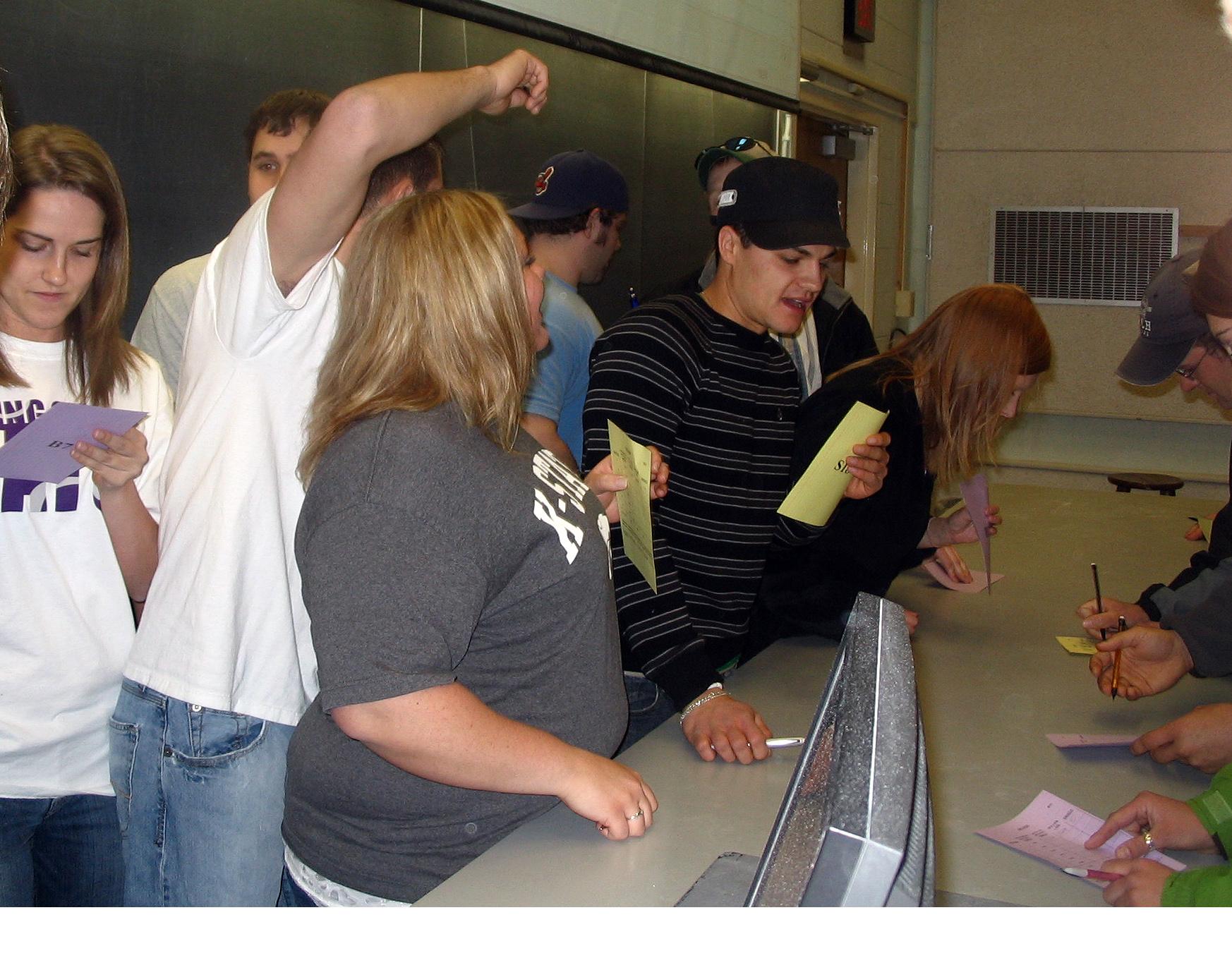 ROUND 1
ROUND 1
Dr. Fox shouted “go” and the first round of trading began. Timid voices offered their product for sale.
“Sell $4.60.”
“Buy $4.40!”
Deals were made and after a minute the round closed. Students recorded their sales and the projector soon featured the prices each group received.
ROUND 2
Dr. Fox admonished the class that they didn’t sound or look like real commodity traders. Challenged by the encouragement, students trading in Round 2 quickly moved to position. Upon the word “go” loud shouting and hustling filled the hall. “Sellers” expressed exasperation that “buyers” wouldn’t meet their price and then the “speculators” stepped in to make the deal. When Dr. Fox called time, the students’ faces were flushed from excitement.
ROUND 3
The students crowded in toward one another, their voices buzzed as they searched for the best contract.
“Buy $4.00, buy $4.00!” one student shouted.
“You’ve got to be kidding me,” another responded. Quickly the minute passed and the round ended. “Now you’ve got it,” Dr. Fox said from the back of the lecture hall impressed with their new found desire and expression.
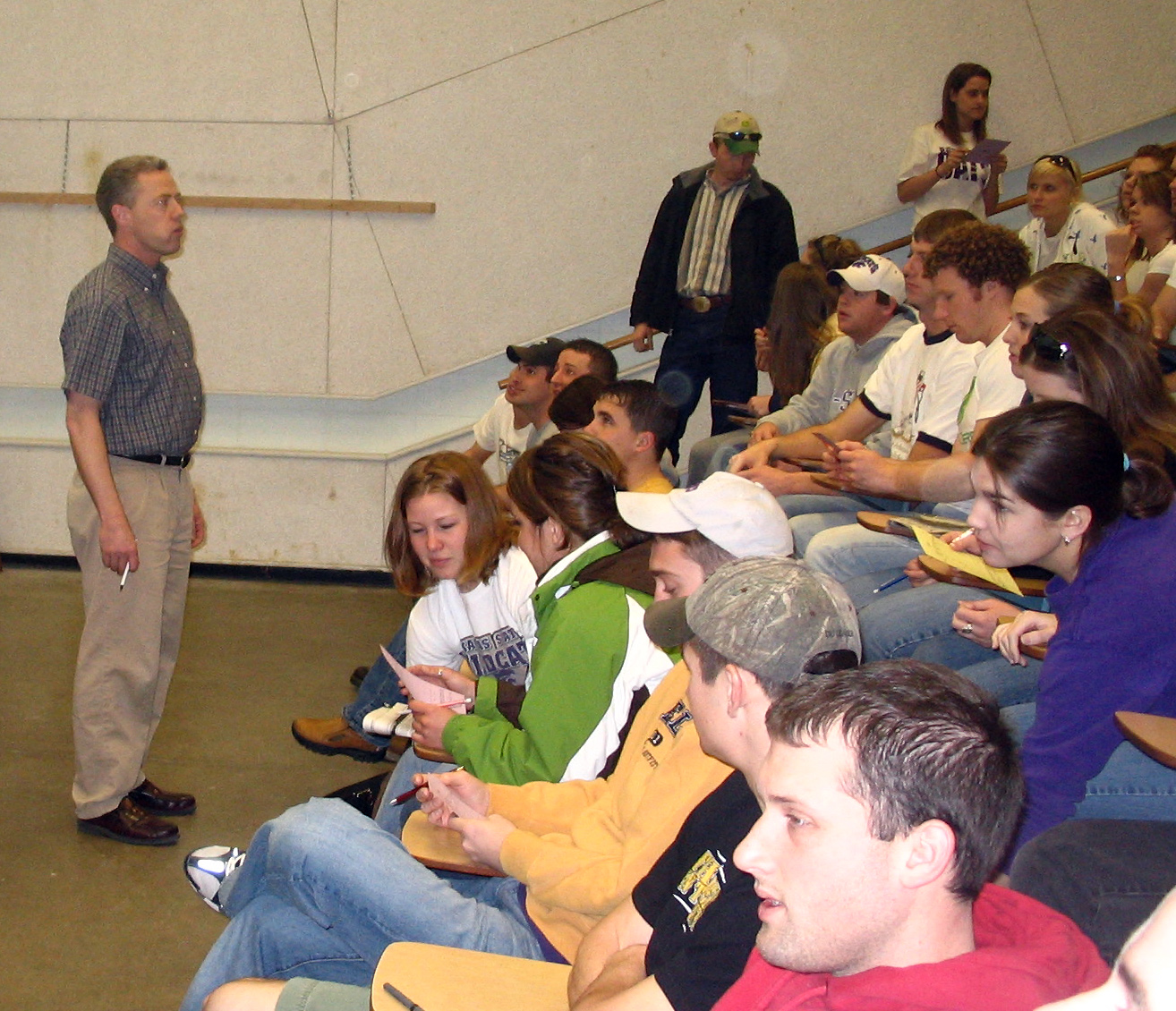 The next round was full of deals and noise followed by two more rounds. Finally students settled down in their chairs and waited for instructions.
The next round was full of deals and noise followed by two more rounds. Finally students settled down in their chairs and waited for instructions.
“So,” Dr. Fox questioned, “Do you all want to be commodity traders?”
“No way!” a student shouted from the back.
“With someone else’s money,” another added to the laughter of his peers.
“Prior to this class I didn’t understand the markets. Today the pressure was just a sliver of what you might experience on a real trading floor,” Shawn Turner, ag economics student, said.
Another purpose of the pit is to show how the information taught in class is realistically applied.
“Students are often cavalier in their desire to speculate, often missing the inherent risk. I want to show them that although they are being thoroughly prepared and equipped with the knowledge needed to pursue careers in trading, there are plenty of factors that need to be considered to make wise decisions,” Dr. Fox said. “Overall, the pit simulation is a great way to actively peak their interest and apply what they’ve studied in an enjoyable format.”
Learning the ropes at a distance
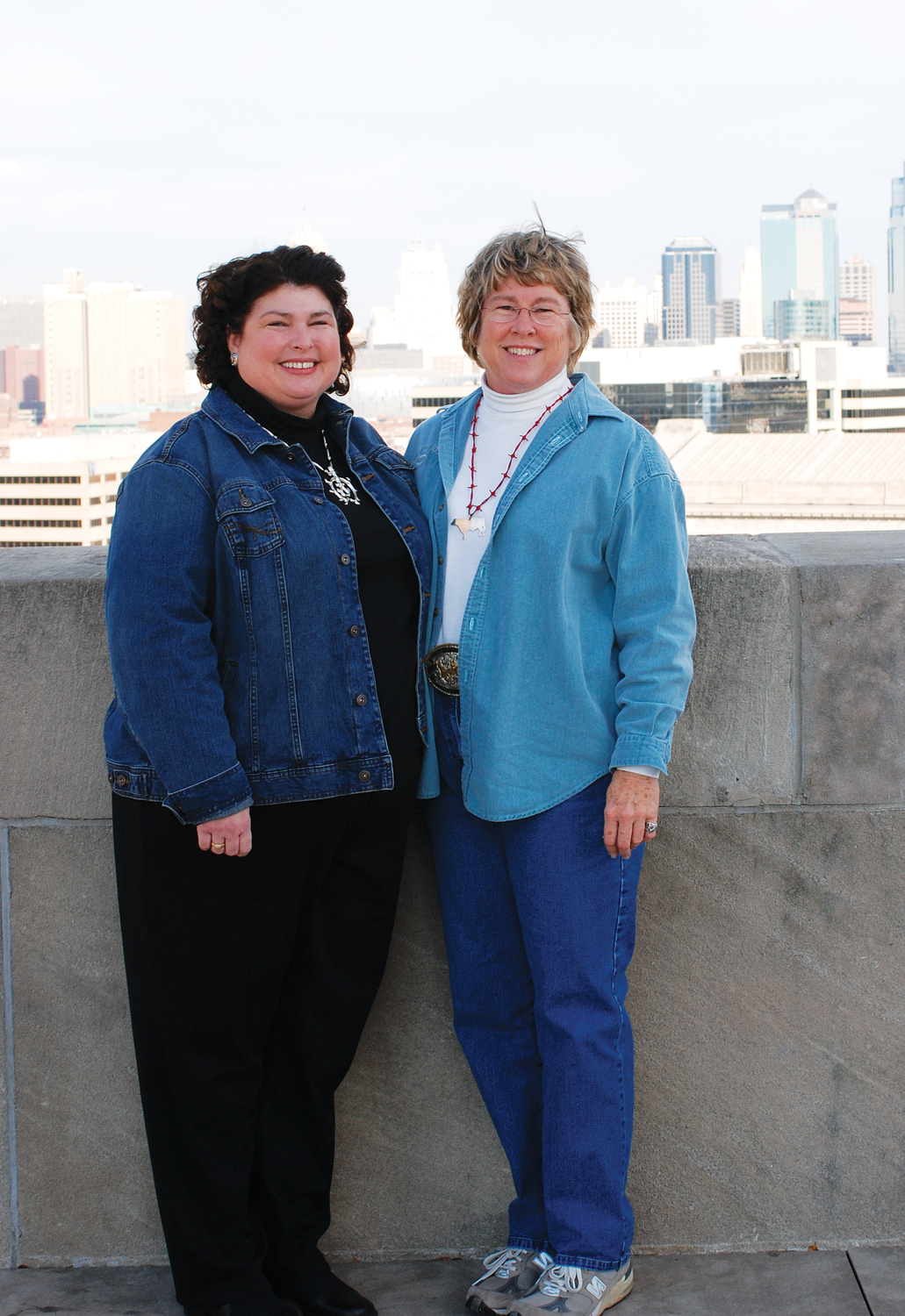 From her home office in the suburbs of Kansas City, Laura Hammond is helping to run the family’s century old business. That wouldn’t be a big deal if the business was closely associated with metropolitan areas. Instead, Hammond is in partnership with her mother in managing two central Kansas cattle ranches.
From her home office in the suburbs of Kansas City, Laura Hammond is helping to run the family’s century old business. That wouldn’t be a big deal if the business was closely associated with metropolitan areas. Instead, Hammond is in partnership with her mother in managing two central Kansas cattle ranches.
Even Hammond admits her current job is a long way from northwest Massachusetts, where she earned an English degree with the intention of teaching and coaching. “Back then,” she laughs, “I didn’t know anything about ranching.”
Hammond is one of nearly 160 Kansans who have completed a four-month distance education course for those interested in managing agricultural operations. The course, called Management, Analysis, and Strategic Thinking (MAST), has been offered by K-State’s Department of Agricultural Economics since 2002.
“The goal of MAST is to have a very comprehensive educational program that goes beyond the traditional two-hour or half-day workshop,” said agricultural economist Kevin Dhuyvetter. “How ever, to do that, we felt it needed to be distance-based so producers could work on their own time.”
With an active young daughter (Sophie) and a husband who travels for his work, Hammond says, “I’m just not very mobile.” Taking distance classes was the perfect fit for her – and the family’s business. “I have a much better picture of our industry and where the family’s business fits into it because of the classes,” said Hammond, who finished the course in spring 2007. “I’d love to take the MAST class again.”
Terry Kastens, a K-State ag economist, said that providing value to real life economics is a key to MAST’s success.
“Busy people in the business world don’t always have time to participate in a degree program. Moreover, they sometimes wish to acquire some education that may not even generally be acquired or available in a traditional degree-based program. In that sense, some distance educational programs may be said to ‘go beyond’ traditional on-campus, degree-based programs.” MAST students initially meet on the K-State campus for two days and again near the end of the program. Otherwise, students complete course modules including such topics as land leasing, tax planning, financial management, and more – on their own time.
In 1999, Hammond’s mother took over as manager of the two ranches – the Mashed O Ranch near Council Grove, and the Cottonwood Ranch near Cottonwood Falls – from her father. The family runs about 1,200 cows and 50 bulls between the two operations. Hammond is the company’s bookkeeper and office manager. She and her mom are the fourth and fifth generations to run the business. Hammond hopes that Sophie may some day become the sixth generation to run the operation. Even though she had not initially intended to get into the ranching business, Hammond says, “I do love the ranch, and it doesn’t surprise me that I got involved. I love the tradition in my family, and I don’t want that to stop after my mom.”
For more information on the MAST program visit: www.agmanager.info/MAST. The 2008-2009 Program begins in November.
Emerald Isle agriculture comes to life
In May, eight students set off for a 10-day tour of Ireland. Aided by his native connection, Dr. Fox put together a fascinating itinerary featuring famous tourist desitnations as well as access to some of Ireland’s influential decision makers in agriculture and policy.
Janet Schlosser, an ag econ grad student, always wanted to travel in the United Kingdom.
“The opportunity this trip provided was fantastic. We got to see many of the typical tourist sites, and many that Americans don’t get to see.”
One of Schlosser’s favorite highlights was touring Kildangan Stud Farm.
Kildangan Stud Farm is located in County Kildare to the southwest of Ireland’s capital city of Dublin. It was developed on the site of the 17th-century Kildangan Castle, and thus the name. Through much of the 20th century Kildangan Stud flourished as a breeding farm, producing 11 European classic winners for the O’ Ferrall family, which had owned the land since 1849.
“The farm is now owned by the ruler of Dubai and each stud horse is worth millions of dollars. The facilities were immaculate and exclusive. However, my preconceptions were off in that they were willing to answer any questions we posed and were very open,” Schlosser said.
In addition to seeing many of Ireland’s famous landmarks like the Galway Cathedral and the White Cliffs of Moher, students toured three working farms including Dr. Fox’s family farm.
Overall, Schlosser said the experience broadened her understanding of agriculture and its unique strengths in different parts of the globe. The wider understanding of Ireland was echoed by many of the students and will be useful as Schlosser continues her graduate studies.
“Being able to go abroad and experience a different culture is valuable, especially when I begin to look for a job after graduation. This experience will make me stand out to potential employers.” Schlosser added.
K-State recovers from June tornado
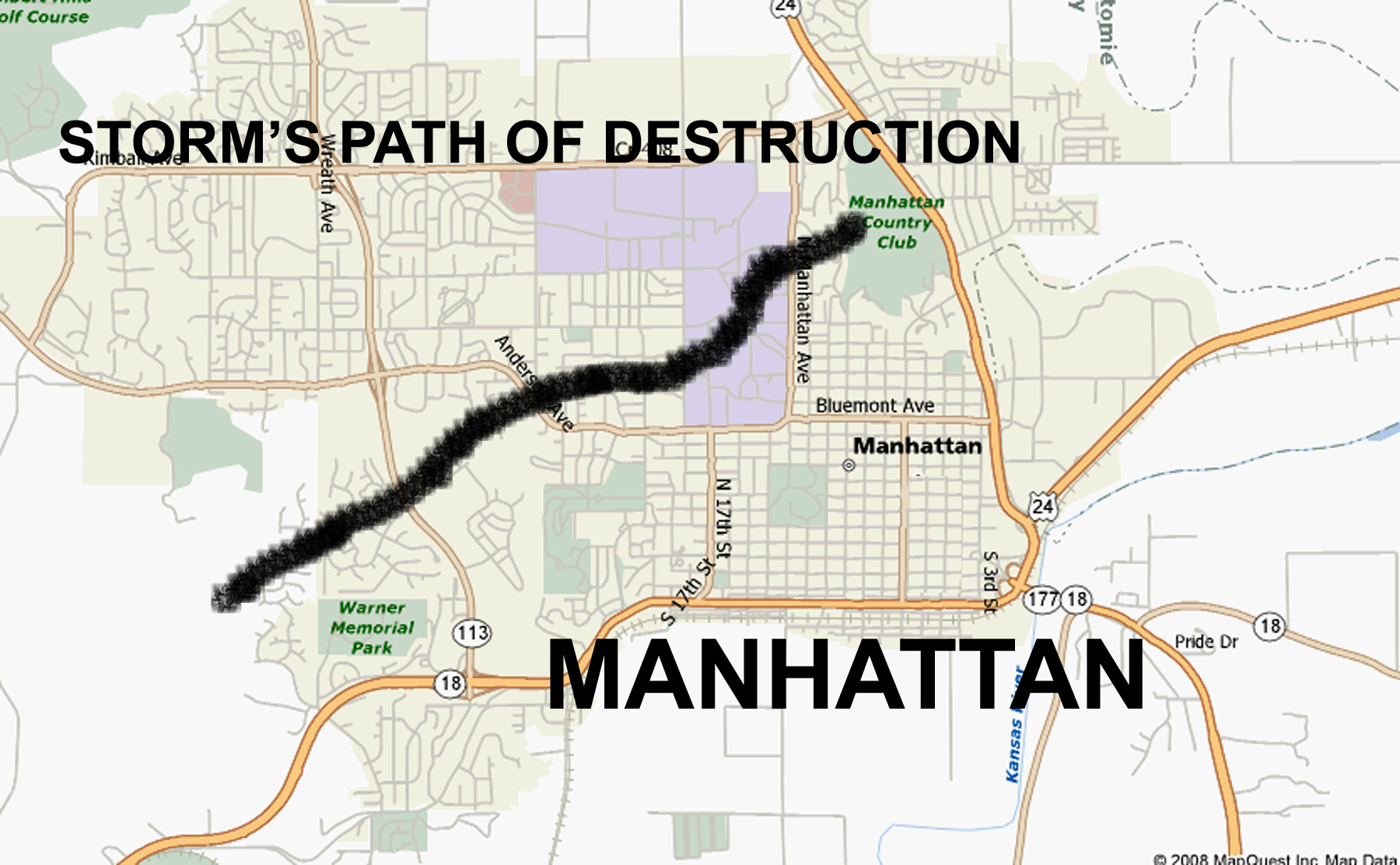 The night of June 11, 2008 found Manhattan residents seeking out protection from an EF-4 tornado. Local news tracked the tornadic system as it wreaked havoc in Salina, devastated the small town of Chapman, KS and eventually struck Manhattan and the K-State campus. In total, 26 campus buildings sustained damage and the park-like landscape disappeared overnight. Buildings worst hit included Waters, Ward, Durland, and Weber. Although the storm left a trail of destruction, no serious injuries or fatalities occured in Manhattan.
The night of June 11, 2008 found Manhattan residents seeking out protection from an EF-4 tornado. Local news tracked the tornadic system as it wreaked havoc in Salina, devastated the small town of Chapman, KS and eventually struck Manhattan and the K-State campus. In total, 26 campus buildings sustained damage and the park-like landscape disappeared overnight. Buildings worst hit included Waters, Ward, Durland, and Weber. Although the storm left a trail of destruction, no serious injuries or fatalities occured in Manhattan.
Over the summer, crews worked cleaning debris and wreckage, replanting green spaces with the goal that when students returned, so would campus normalcy.
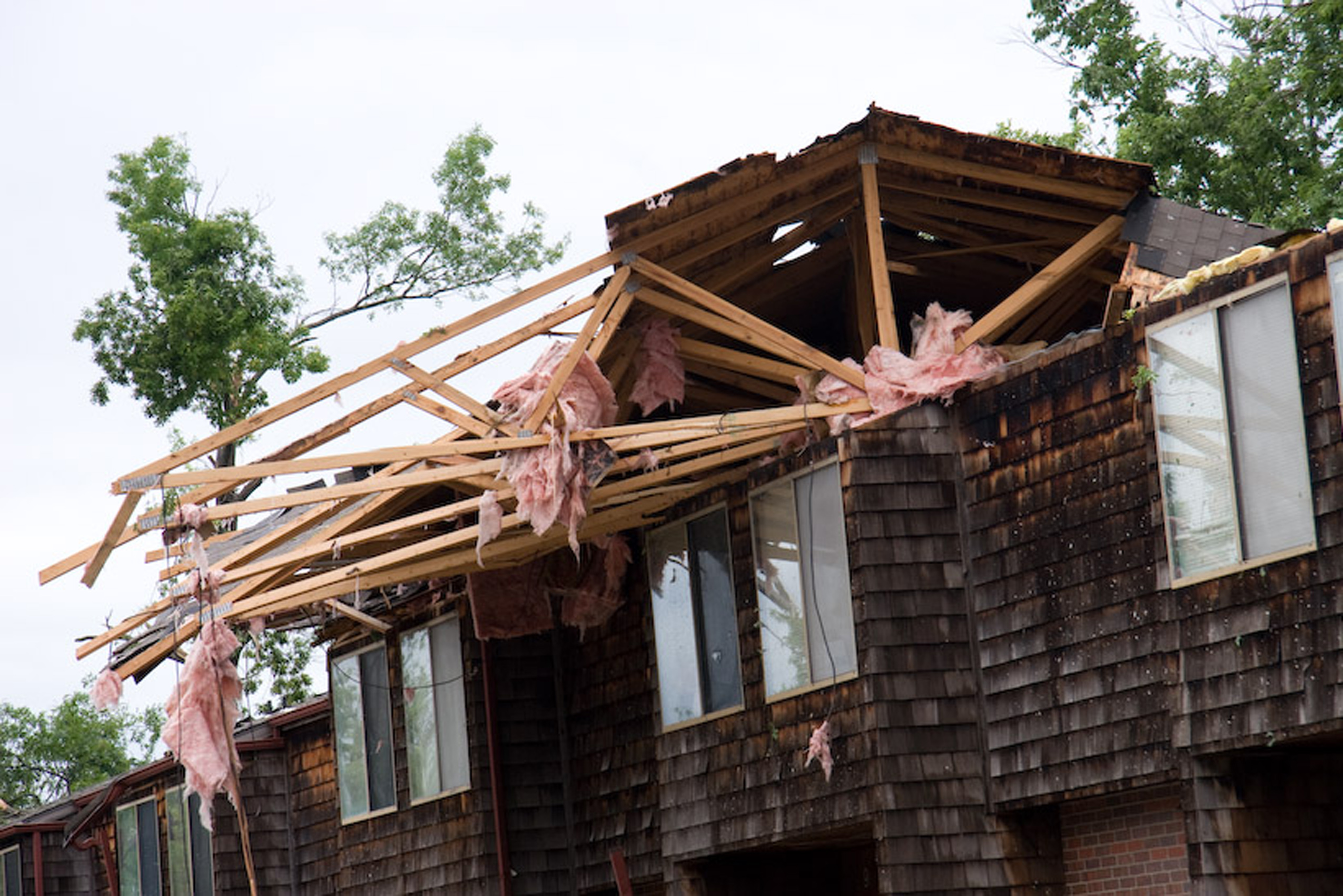 Bruce Shubert, associate vice president for administration and finance, said the clean-up effort has shifted from securing buildings temporarily to fixing them permanently.
Bruce Shubert, associate vice president for administration and finance, said the clean-up effort has shifted from securing buildings temporarily to fixing them permanently.
“Our immediate goal was to make the buildings safe and weather-tight,” he said. “That’s where you saw workers removing debris and boarding up windows. Now we’re completing permanent repairs.”
President Jon Wefald said the clean up results have been impressive. In celebration of the recovery, he hosted a campus-wide ice cream social on the Quad in front of Waters Hall.
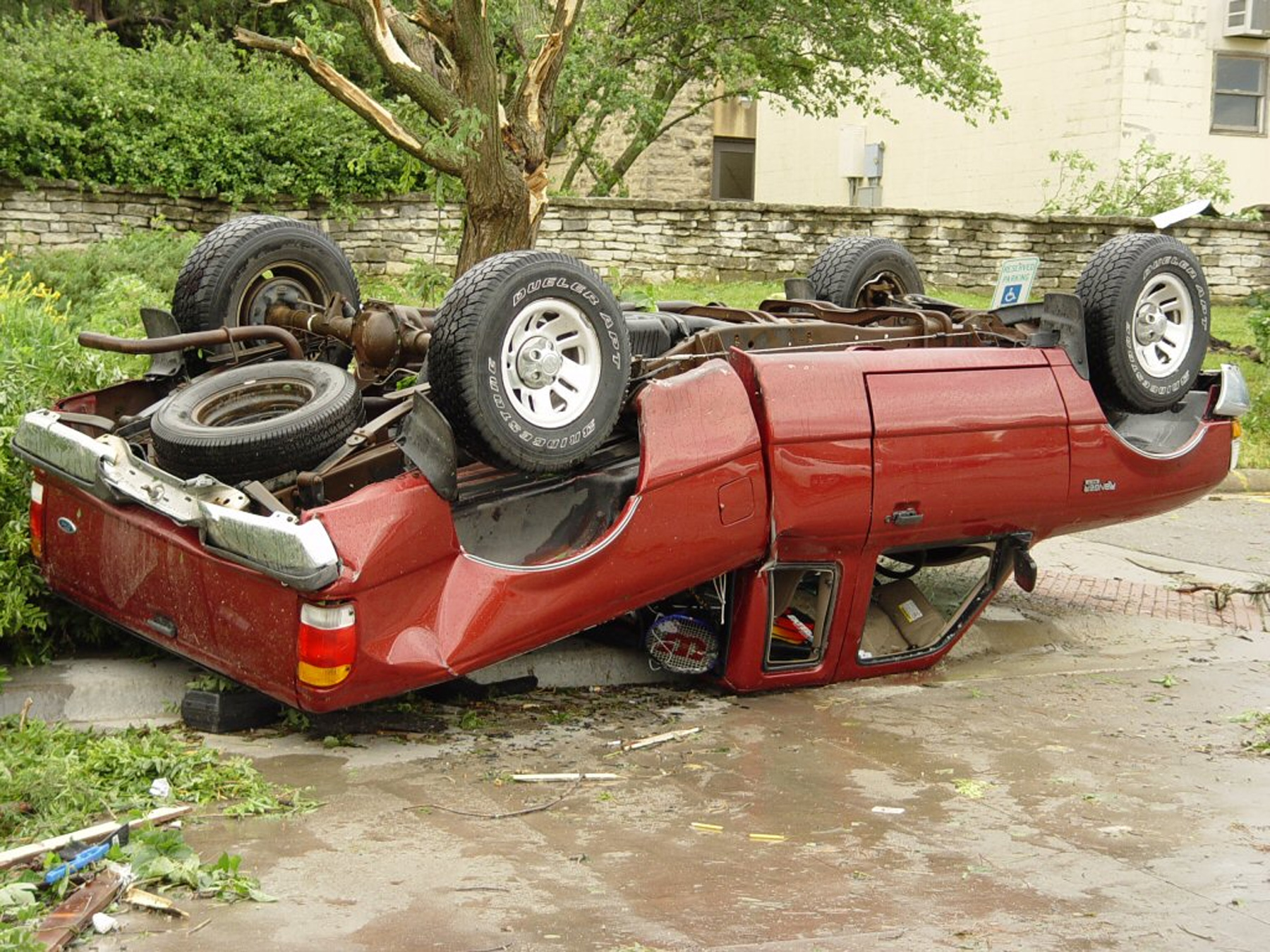 “Except for when these buildings were built, I would guess the campus has never been cleaner,” he said. “I think people will be shocked when they come back, look around and say, ‘What tornado?’”
“Except for when these buildings were built, I would guess the campus has never been cleaner,” he said. “I think people will be shocked when they come back, look around and say, ‘What tornado?’”
Agricultural economics Professor Orlen Grunewald found his office in disarray after the tornado.
“My immediate thought was ‘thank goodness it wasn’t worse.’ My office had broken glass from the windows 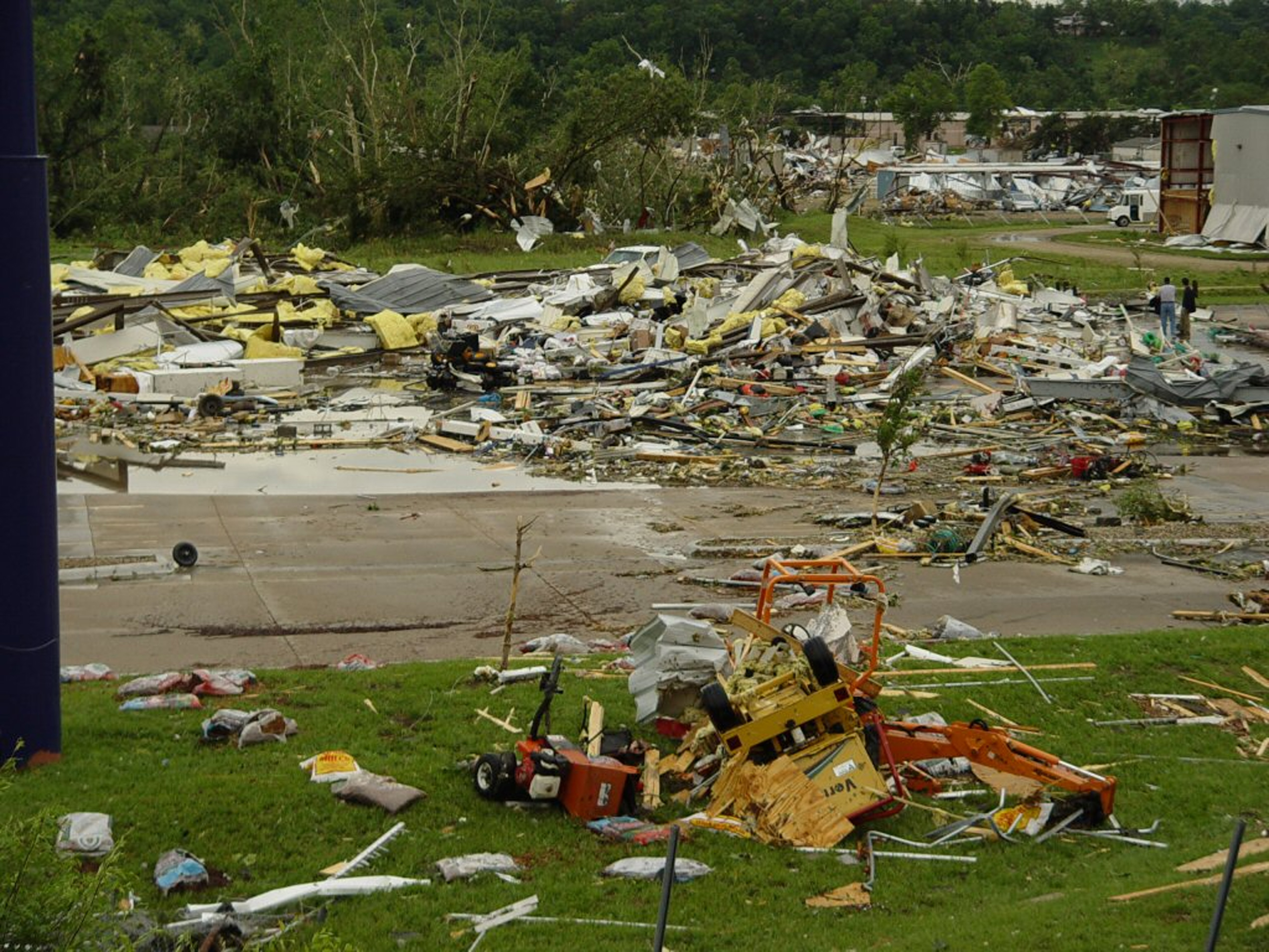 all over the floor and a missing ceiling,” he said. “However, just a few feet away a stack of papers hadn’t been touched.”
all over the floor and a missing ceiling,” he said. “However, just a few feet away a stack of papers hadn’t been touched.”
K-State would like to thank the community and friends for their time, work, and generous donations in the recovery effort.
![]()
Ag Econ Alumni and Faculty honored for career success
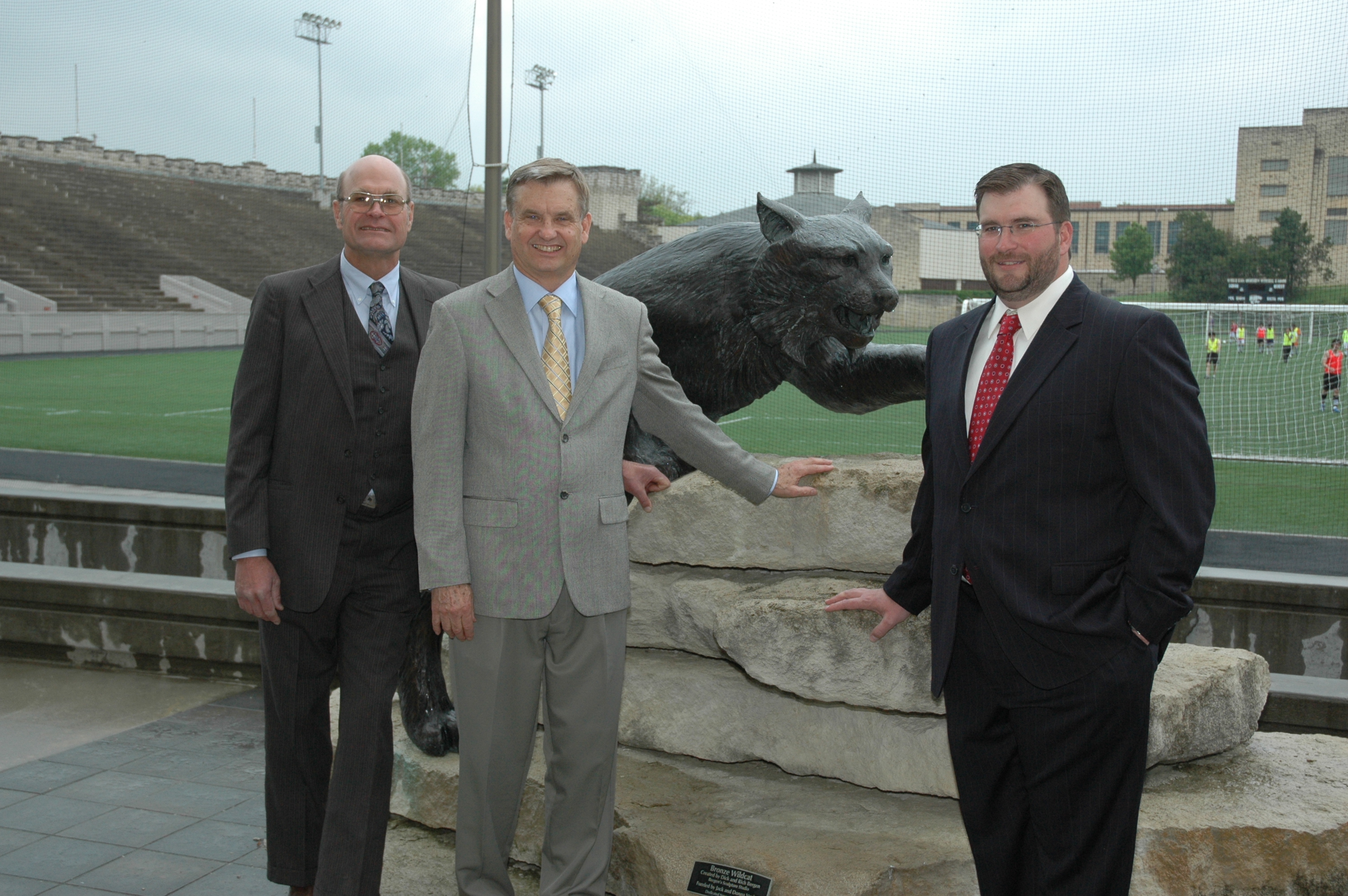 It was a clean sweep for Department of Agricultural Economics alumni and faculty at the 2008 Wild4Ag Weekend. Rich Porter is the Distinguished Alumnus Award Winner. Porter is a farmer and cattle feeder from Reading, Kansas. He was among the inaugural Masters in Agribusiness class. His operation includes 8,000 head of finishing cattle and 15,000 acres of crops and pasture. Michael Doane, director of industry affairs for Monsanto Company is the Outstanding Young Alumnus. At Monsanto he concentrates on sustainability issues. He continues to be involved at K-State by serving on the dean and director’s advisory council. Arlo Biere, professor, was presented the David J. Mugler Outstanding Teaching Award. Biere was part of a team that constructed the basis for current curriculum in 1972 and has led the department’s undergraduate program since 1987. Congratulations to each on their honor as successful contributors to agriculture and K-State.
It was a clean sweep for Department of Agricultural Economics alumni and faculty at the 2008 Wild4Ag Weekend. Rich Porter is the Distinguished Alumnus Award Winner. Porter is a farmer and cattle feeder from Reading, Kansas. He was among the inaugural Masters in Agribusiness class. His operation includes 8,000 head of finishing cattle and 15,000 acres of crops and pasture. Michael Doane, director of industry affairs for Monsanto Company is the Outstanding Young Alumnus. At Monsanto he concentrates on sustainability issues. He continues to be involved at K-State by serving on the dean and director’s advisory council. Arlo Biere, professor, was presented the David J. Mugler Outstanding Teaching Award. Biere was part of a team that constructed the basis for current curriculum in 1972 and has led the department’s undergraduate program since 1987. Congratulations to each on their honor as successful contributors to agriculture and K-State.Back to top
